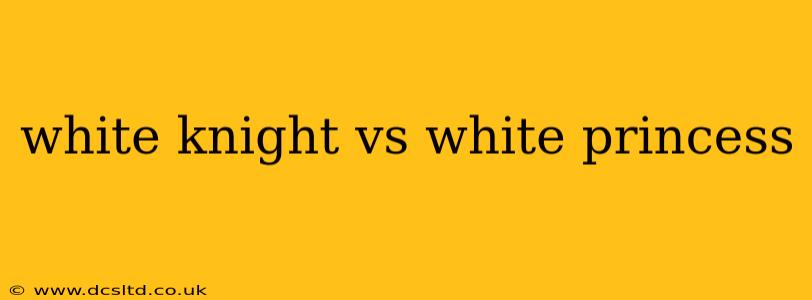The "White Knight" and "White Princess" are archetypes that appear frequently in literature, film, and even real-life relationships. While both represent idealized figures often associated with purity, goodness, and rescuing damsels, they possess distinct characteristics and motivations. Understanding these differences is crucial to appreciating their roles in storytelling and recognizing their potential pitfalls in real-world interpretations.
What is a White Knight?
A White Knight is a heroic figure who often rescues a damsel in distress. This rescue might involve physical bravery, overcoming social obstacles, or simply offering unwavering support. He's often characterized by:
- Selflessness: He prioritizes the needs of others, particularly the "princess" he's sworn to protect.
- Chivalry: He adheres to a traditional code of conduct, displaying courtesy, honor, and respect.
- Idealism: He often holds unrealistic expectations of himself and others, believing in a perfect world and striving for perfection.
- Potential for Obsession: In some portrayals, the White Knight's dedication borders on obsession, potentially blinding him to the princess's own agency and needs.
What is a White Princess?
The White Princess archetype is often the recipient of the White Knight's attention. She's frequently portrayed as:
- Vulnerable: She requires rescuing, often due to societal constraints, personal weakness, or external threats.
- Passive: She often awaits rescue rather than actively participating in her own salvation.
- Dependent: She relies heavily on the White Knight for protection and guidance.
- Idealized: She often embodies purity, innocence, and beauty, representing an unattainable ideal.
What are the Key Differences Between a White Knight and a White Princess?
The core difference lies in their agency and roles within the narrative. The White Knight is the active rescuer, while the White Princess is the passive recipient of rescue. This dynamic can create an imbalance of power, where the princess's autonomy is diminished. While the intention behind the White Knight's actions is often benevolent, the execution can inadvertently perpetuate unhealthy dependency.
Are White Knights and White Princesses Always Negative?
No. While these archetypes can represent problematic power dynamics, they also serve as powerful symbols of hope, protection, and idealism. Modern interpretations often subvert or reimagine these roles. For instance, a strong female character might embody aspects of both archetypes, rescuing herself while simultaneously demonstrating acts of chivalry towards others. The key lies in the nuanced portrayal and avoiding harmful stereotypes.
How can these archetypes be harmful in real-life relationships?
The White Knight archetype can foster codependency and stifle individual growth. The White Princess role can lead to learned helplessness and a lack of self-reliance. Healthy relationships require mutual respect, agency, and equal partnership, qualities often absent in the traditional portrayal of these archetypes.
How can these archetypes be reimagined in a positive light?
Contemporary storytelling often reimagines these archetypes to showcase empowered individuals. The White Knight's selflessness can become proactive support without controlling behavior. The White Princess can evolve into a strong, independent woman who accepts help but doesn't rely solely on others for her well-being. This evolution reflects a more balanced and healthy dynamic.
What are some examples of White Knights and White Princesses in popular culture?
Examples abound in fairy tales, classic literature, and modern media. However, critically examining these portrayals reveals the complexities and potential pitfalls of these archetypes. Consider the difference between a traditional portrayal of Prince Charming and a more modern, complex depiction of a heroic male character who respects the female lead's agency.
In conclusion, understanding the White Knight and White Princess archetypes provides valuable insight into the dynamics of power, rescue narratives, and the complexities of human relationships. While traditionally associated with idealized notions of goodness and heroism, a critical examination reveals the potential for harmful stereotypes and unhealthy power imbalances. Modern interpretations strive to subvert these traditional depictions, creating more balanced and empowering representations.
